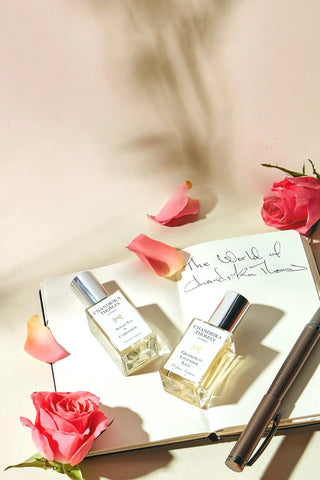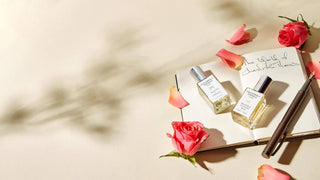The fascinating science (and quiet magic) behind your signature scent
Have you ever fallen in love with the way a perfume smells on someone else, only to find it changes entirely on your own skin? Perhaps what seemed soft and floral turned sharp and woody, or a scent that was light and fresh on a friend felt unexpectedly heavy on you. It’s one of perfumery’s most intriguing mysteries, how a single fragrance can reveal such different personalities depending on who wears it.
This is chemistry and artistry intertwined. Perfume is a living creation, a delicate orchestra of natural oils, resins, and aroma molecules that come alive only when they meet you: your skin, your temperature, your habits, even the way you dress. The result is a scent that becomes as individual as a fingerprint.
Understanding why this happens allows you to appreciate perfume not just as something you wear, but as something that evolves with you. In this note, we’ll explore the science behind this quiet magic, from body chemistry and skin pH to climate, materials, and memory, and how you can use that knowledge to choose perfumes that harmonise perfectly with your natural scent.
Because when you understand the relationship between fragrance and skin, you no longer just wear perfume, you co-create it.

Skin Chemistry: Your Invisible Co-Perfumer
Perfume = volatile aromatic molecules + alcohol + your skin.
The moment fragrance lands on skin, evaporation begins, and molecules mingle with your natural oils. That interaction shapes the balance of top, heart, and base notes.
-
pH (skin acidity): Most skin sits around pH 4.7–5.5 (lightly acidic). Slightly more acidic skin can sharpen citrus and green notes; more neutral skin may soften edges and let florals or woods read smoother.
-
Sebum (natural oil):
-
Oilier skin tends to hold perfume better and can amplify base notes (woods, amber, musk), often giving a richer, longer dry-down.
-
Drier skin may lose top notes quickly and can make fragrances feel thinner or more powdery; moisturising first gives perfume something to “grip.”
-
Skin temperature: Warm skin speeds evaporation, boosting projection (sillage) but potentially shortening longevity of top notes. Cooler skin mutes lift, but can extend the hush of heart and base notes.
Analogy: Your skin is the canvas; perfume is the paint. Texture, tone, and warmth change how the colour sets.

Body Chemistry & Lifestyle: More Than Skin Deep
Your internal rhythm and daily choices also shape a perfume’s development.
-
Hormonal shifts: Natural cycles, pregnancy, peri-menopause, stress, or intense exercise can subtly alter body odour and skin oils, nudging a fragrance warmer, sweeter, or drier.
-
Diet: Spices, garlic, and high-fat foods can influence body scent and, therefore, the base that perfume sits on. Hydration helps fragrances bloom more evenly.
-
Medications & supplements: Some can change skin dryness or pH, which can tilt a fragrance brighter or more subdued.
-
Skincare & soap: Residual fragrance in shower gels, body creams, and laundry detergents can clash or create new accords on the skin. A neutral, unscented moisturiser is best before testing perfume.
-
Fabric & hair: Scent on natural fibres (wool, silk, cotton) diffuses differently than on synthetics. Hair holds fragrance beautifully, but go lightly, the alcohol can be drying; a mist from arm’s length is enough.

The Fragrance Architecture: Notes, Materials, Concentration
A perfume’s internal structure is designed to evolve:
-
Top notes (first impression): Lightest, most volatile (e.g., bergamot, lemon, green herbs). They flash brightest on warm, oily skin and in warm climates.
-
Heart notes (character): Florals, spices, aromatics. This forms the very soul and personality of the perfume.
-
Base notes (foundation): Heavier, slower to evaporate (woods, amber, resins, musks). They cling to fabric and to oilier skin, shaping the final trail.
Natural vs. nature-identical vs. synthetic:
-
Naturals (e.g., real jasmine, patchouli, resin) contain hundreds of molecules. They’re beautifully complex, and therefore more variable from skin to skin.
-
Modern aromachemicals (e.g., Iso E Super, Ambroxan) are more linear and stable, often giving a cleaner, more predictable aura, though some people are selectively less sensitive to them (more on this below).
Concentration & format:
-
Eau de Parfum (EDP) usually projects more than Extrait/Parfum, which sits closer to the skin with a richer, slower bloom.
-
Perfume oils skip alcohol, often wearing softer and longer with lower projection, sometimes a better match for drier or sensitive skin.
-
Eau Fraîche/Cologne shines in heat but vanishes sooner.
Choosing the right concentration for your skin and climate can transform your experience of the same composition. I’ve written a dedicated note about perfume concentrations, read it here for more details
.

Environment: Climate, Humidity, and Space
Where you wear perfume changes how it performs.
-
Temperature: Heat lifts top notes; cold favours base notes. A citrus-fresh perfume may sparkle outdoors in July and feel shy in January.
-
Humidity: Moist air enhances florals and fruits; very dry air emphasises woods, smoke, or powder.
-
Airflow & room size: A large, airy gallery diffuses scent differently than a cosy dining room. Outdoors, wind disperses fragrance faster; on fabric under a coat, it warms and concentrates.
The same fragrance can feel airy and sun-lit on a summer afternoon in Chelsea, then deepen into soft woods and amber on a chilly December evening in Marylebone.

Perception: Your Nose, Your Mind
Two people smelling the same cloud of scent may perceive it differently.
-
Anosmia & partial anosmia: Some people have reduced sensitivity to certain musks or woody molecules; they’ll report a perfume as “light” while others find it enveloping.
-
Olfactory fatigue (nose-blindness): Your brain tunes out familiar aromas within minutes; others still smell your perfume clearly.
-
Associations & mood: Memory and context colour perception. the same jasmine can feel romantic one day and heady the next.
This is why a perfume that seems “subtle” to you may be perfectly present to everyone else.

Why Our Perfumes Evolve So Beautifully on Skin
At Chandrika Thomas London, our compositions are rich with fine botanical ingredients precisely because we love how they come alive with the wearer:
-
Marrakesh (a favourite signature for many of our cherished customers) entwines jasmine, tuberose and orange blossom with amber crystals, patchouli, and tonka bean. On warmer skin, the white florals glow; on cooler days, the amber-woody base takes the lead.
-
Thyme & Mandarin Fig stays crisp and luminous in heat, the fig and citrus feeling wonderfully clean on well-hydrated skin.
-
Reminisce Smoky & Spicy Patchouli finds a velvety, cocooning depth on fabric and in cool air; a perfect example of base-note elegance.
Variation is the artistry of haute perfumery in motion.

How to Test Perfume Properly (and Choose What Suits You)
A professional, step-by-step method your readers can actually use:
-
Start neutral.
Shower with an unscented cleanser. Moisturise with an unscented lotion to give fragrance a smooth surface. -
Apply to skin, not paper.
Use one spray on each wrist (no rubbing, it bruises top notes). Optional: one light mist on the collarbone or inner elbow. -
Give it time.
Smell at 3 minutes (top), 30 minutes (heart), and 2–3 hours (base). Notice the “arc” rather than chasing the first burst. -
Test in different settings.
Try the same perfume on a warm, active day and on a cool, calm evening. You’re learning how you wear the fragrance, not just how it smells in the air. -
Check fabric vs skin.
A whisper on a silk scarf or wool coat shows the base more prominently and lasts longer. (Avoid spraying delicate fabrics up close.) -
Mind your routine.
Skip competing scented lotions. If you love matching care, use fragrance-compatible body products (neutral or coordinated). -
Hydration helps.
Well-hydrated skin = better diffusion and longevity. Drink water; moisturise lightly before wearing. -
Compare concentrations.
If an EDP is “too bright” on you in summer, try the extrait or oil for a closer, creamier aura. -
Respect your nose.
If you “stop smelling” your perfume, step into fresh air for a moment. It’s usually olfactory adaptation, not disappearance.

Troubleshooting: If a Perfume Doesn’t Behave on You
-
Too sharp/acidic?
Try moisturising first; test in cooler weather; sample the extrait/oil format; layer a neutral, unscented cream underneath to soften and lift. -
Disappears too quickly?
Hydrate skin; apply to pulse points and lightly to fabric; consider a richer concentration; try in cooler weather. -
Too sweet or heavy?
Reduce sprays; apply lower on the body (stomach, back of knees) for a softer aura; wear in cooler air. -
Headaches or sensitivity?
Go lighter, try fabric-only, or choose gentler materials and lower projection. If persistent, choose softer families (sheer florals, airy aromatics).

Choosing Your Fragrance Family (and Why It May Vary by Skin)
Certain families tend to read differently depending on skin type and climate:
-
Citrus/Green/Herbal: Sparkling, quick to lift; glorious on warm, hydrated skin. May feel fleeting on very dry skin; try fabric support.
-
White Florals (jasmine, tuberose, orange blossom): Bloom with warmth; on some skins they turn creamy, on others more radiant and airy.
-
Woods/Amber/Resins: Excellent longevity, especially in cooler air or on oilier skin. On very warm skin, they can feel fuller; one or two sprays may suffice.
-
Gourmand/Vanilla/Tonka: Cosy and enveloping; dry skin can make them powdery, while warm skin may make them rounder and sweeter.
-
Aromatics/Spices: Highly expressive with movement and heat; in cold air, they settle into a refined, intimate trail.
Exploring across families helps you discover not only what you love, but how you wear it best.

Perfumers expect fragrance to vary slightly from one wearer to the next; that’s the point. A beautifully crafted perfume meets your skin and becomes yours. On one person, jasmine hums like silk; on another, amber glows like candlelight. No two wearers will smell identical, and that individuality is precisely what makes perfume such an intimate luxury.
At Chandrika Thomas London, we compose with this in mind: perfumes designed to honour both identity and evolution, shaped by the warmth of your skin and the rhythm of your days.
Curious to discover how our perfumes evolve on your skin? Begin with our Full Discovery Perfume Set, a refined way to test across fragrance families, seasons, and settings, and to find the compositions that feel unmistakably you. Explore your personal chemistry with Chandrika Thomas London, perfumes crafted to become part of your story.



